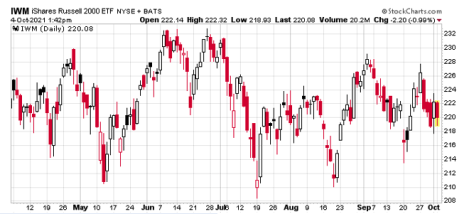Bear Call Spread Options Strategy - Russell 2000 (IWM)
As I have stated over the past few weeks, bear call spreads are a good strategy for this market environment.
And with implied volatility up again, the bearish-leaning options strategy looks even more attractive, whether as a hedge or simply to act on a directional bias.
[text_ad use_post='261460']
Remember, as I’ve discussed on a few occasions, with a bear call spread I have a decent margin of error just in case the stock, or ETF in this case, pushes higher. If it pushes lower, particularly if it is immediate, I should be able to lock in a quick gain.
In late August, we placed a bear call spread in the SPDR S&P 500 ETF (SPY). Several weeks ago we spoke about the potential of locking in 12.4%. Now the spread trades for roughly $0.12 for a profit of 14.9%.
Back in mid-September we mentioned another bear call spread in IWM. One week later the spread trades for $0.30 for a quick profit of 9.9%. The max potential profit on the high-probability trade is 17.6%.
On September 20, we mentioned another trade idea in SPY. We sold the 455/460 bear call spread for $1.37. Now it trades for $0.53. We can currently lock in 20.2% in profits.
I’m going to continue to push the envelope this week with another potential hedge/bearish-leaning trade in IWM.
The Trade
With the Russell 2000 (IWM) trading for 222.14 I want to place a short-term bear call spread going out 46 days. My intent is to take off the trade well before the November 19, 2021 expiration date. For this bearish spread example, my preference is to go with a trade that has around an 80% to 85% probability of success.
The Trade – Bearish Spread Example
Let’s start by taking a look at the options chain for IWM with 46 days until expiration. Once we choose our expiration cycle (it will differ in duration depending on outlook and strategy), we begin the process of looking for a call strike within the November 19, 2021 expiration cycle that has over around an 80% probability of success.
If you don’t have access to probabilities of success on your trading platform look towards the delta. Without going into too much detail, look for a call strike that has a delta around 0.20.
Next, I want to know what the expected move or expected range is for IWM during the November 19, 2021 expiration cycle. The range is currently from 238 to just under 202.
Since we are focused on using a bearish spread example, we only care about the upside risk at the moment.
By knowing that the market anticipates IWM going as high as 238 by November expiration in 46 days, it allows us to choose a short call strike around that number. This will define our probability of success on the trade.
The 235 call strike with an 81.82% probability of success works. It’s not outside of the expected range, but we can adjust accordingly if needed. I want to have an opportunity to bring in roughly 25%, while keeping my probability of success around 80%.
The short 235 call strike defines my probability of success on the trade. It also helps to define my overall premium or return on the trade. Basically, as long as IWM stays below the 235 call strike at the November 19, 2021 expiration in 46 days we will make a max profit on the trade. But, as I stated before, my preference is to take off profits early and, in most cases, reestablish a position if warranted.
Also, time decay works in our favor on the trade, so as we get closer and closer to expiration our premium will erode at an accelerated rate. As a result, we should have the opportunity to take the bear call spread off for a nice profit prior to expiration–unless of course IWM spikes to the upside over the next 46 days. But still, that doesn’t hide the fact that with this trade, we can be completely wrong in our directional assumption and still make a max profit.
Once I’ve chosen my short call strike, in this case the 235 call, I then proceed to look at the other half of a 3-strike wide, 4-strike wide and 5-strike wide spread to buy.
The spread width of our bear call defines our risk/capital on the trade.
The smaller the width of our bear call spread the less capital required, and vice versa for a wider bear call spread.
When defining your position size, knowing the overall defined risk per trade is essential. Basically, my spread width and my premium increase as my chosen spread width increases.
Bearish Spread Example: November 19, 2021 235/239 Bear Call Spread or Short Vertical Call Spread
Now that we have chosen our spread, we can execute the trade.
Simultaneously:
Sell to open IWM November 19, 2021 235 strike call.
Buy to open IWM November 19, 2021 239 strike call for a total net credit of roughly $0.77 or $77 per bear call spread.
- Probability of Success: 81.94%
- Total net credit: $0.77, or $77 per bear call spread
- Total risk per spread: $3.23 or $323 per bear call spread
- Max Potential Return: 23.8%
As long as IWM stays below our 235 strike at expiration in 46 days, I have the potential to make a max profit of 23.8% on the trade. In most cases, I will make less, as the prudent move is to buy back the bear call spread prior to expiration. Again, I look to buy back a spread when I can lock in 50% to 75% of the original credit. Since we sold the spread for $0.77, I would look to buy it back when the price of my spread hits roughly $0.37 to $0.20.
Of course, there are a variety of factors to consider with each trade. And we allow the probabilities and time to expiration to lead the way for our decisions. But, taking off risk, or at least half the risk, by locking in profits is never a bad decision and by doing so we can take advantage of other opportunities the market has to offer.
Risk Management
Since we know how much we stand to make and lose prior to order entry we can precisely define our position size on every trade we place. Position size is the most important factor when managing risk, so by keeping each trade at a reasonable level (I use 1% to 5% per trade) allows not only the Law of Large Numbers to work in your favor … it also allows you to sleep well at night.
I also tend to set a stop-loss that sits 1 to 2 times my original credit. Since I’m selling the 235/239 bear call spread for $0.77, if my bear call spread reaches approximately $1.54 to $2.31, I will exit the trade.
As always, if you have any questions, please do not hesitate to email me or post a question in the comments section below.


